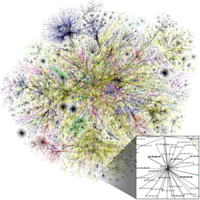
Photo from wikipedia
Adversaries perform port scanning to discover accessible and vulnerable hosts as a prelude to cyber havoc. A darknet is a cyberattack observation network to capture these scanning activities through reachable… Click to show full abstract
Adversaries perform port scanning to discover accessible and vulnerable hosts as a prelude to cyber havoc. A darknet is a cyberattack observation network to capture these scanning activities through reachable yet unused IP addresses. However, the enormous amount of packets and superposition of diverse scanning strategies prevent extracting significant insights from the aggregate traffic. Some coordinated scanners disperse probe packets whose TCP/IP header follows a unique pattern to determine whether the received packets are valid responses to their probes or are part of other background traffic. We call such a pattern a fingerprint. For example, a probe packet from a Mirai-infected host satisfies a pattern whereby the destination IP address equals the sequence number. A fingerprint indicates that the source host has been involved in a particular scanning campaign. Although some fingerprints have been discovered and known to the public, there are and will be more undiscovered ones. We intend to unveil these fingerprints. Our preliminary work automatically identified flexible fingerprints but overlooked low-rate and coordinated scanners. In this work, we improved the fingerprint identifier, enabling it to detect these stealth scans. Moreover, we revealed the scans’ objectives by investigating destination port sets. We associated fingerprints with threat intelligence and verified their reliability. Our approach identified all well-known and eight unknown fingerprints on one month’s worth of darknet data collected from about three-hundred thousand unused IP addresses. We disclosed the fingerprints of the Mozi botnet and destination port sets that were previously unreported.
Journal Title: IEEE Access
Year Published: 2023
Link to full text (if available)
Share on Social Media: Sign Up to like & get
recommendations!